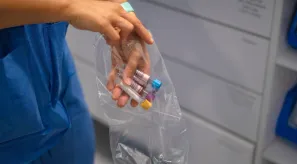After the cremation of a loved one, the need to open the urn may sometimes arise. This can be for different reasons: fulfilling the deceased’s wish to scatter their ashes in a place with symbolic value, transferring them to another more suitable urn, or dividing them among several family members.
Whatever the reason, the truth is that many people wonder how to open an urn correctly, without damaging the container or risking the contents. This is a very common doubt because not all urns open in the same way. They have different types of closures, and forcing a lid without knowing the system can cause accidental spillage or damage to the urn.
In this article, you will find a step-by-step guide that explains the types of closures, how to open the urn safely, and what precautions you should keep in mind.
Types of urn closures
The type of closure is the first aspect to consider before attempting to open an urn. There are two main systems: urns with a screw-top lid and urns with a sealed lid.
Urns with screw-top lids
Urns with screw-top lids are one of the most common models. They work in a similar way to a jar: the lid is screwed onto the body of the urn and opens by turning it counterclockwise.
These are the main advantages of screw-top urns:
- They are easy to open and close.
- They do not require special tools.
- They provide security but at the same time allow easy access.
This type of closure is common in metal or wooden urns. It is especially practical when it is expected that the ashes may be handled on more than one occasion, such as in the case of transfers or divisions among family members.
Urns with sealed lids
In other cases, the urn may come sealed with adhesive or silicone. This technique ensures that the lid will not open by accident and that the contents are completely protected.
Characteristics of sealed urns:
- They are more secure against spills.
- They are intended for a more permanent use.
- Opening them requires time and care, as simply turning the lid is not enough.
This type of urn is usually delivered directly by the crematorium, especially when the family has not requested to handle the ashes immediately.
Steps to open an urn
Once the type of closure has been identified, you can proceed with the opening. Doing so calmly and in a safe environment is essential.
Identify the type of urn
The first step is to carefully observe the urn. Ask yourself: does the lid seem screwed on or glued? Is there a visible silicone joint? If you are unsure, it is best to consult the funeral home that delivered the urn, as they will be able to confirm the type of closure. Knowing this detail will prevent damage to the urn and accidents during handling.
Turn the lid if it is a screw-top urn
In the case of screw-top urns, simply turn the lid counterclockwise.
If the lid is very tight or has been closed for a long time, it may be helpful to wrap it with a dry cloth to improve grip and make a slow, steady movement without applying excessive force. It is advisable to perform this operation on a table covered with a towel so that any particle of ash is contained in case it comes loose.
Dab cotton with alcohol to weaken the adhesive if sealed
With urns that have a sealed lid, the procedure is different. The lid is usually fixed with a strong adhesive, so it is recommended to use alcohol to weaken it.
The process is simple:
- Soak a cotton ball with alcohol.
- Gently run it along the joint between the lid and the body of the urn.
- Let it sit for a few minutes so that the adhesive softens.
- Repeat the process if necessary until the lid can be removed gently.
This method is safe and prevents damage to the urn or risking the contents. It is never advisable to pry with sharp tools, as they could break the lid or cause an unexpected spill.
Precautions when opening an urn
Opening a funeral urn is not just any gesture: it requires respect, care, and a prepared environment to ensure everything goes smoothly.
Some important recommendations are:
- Use disposable gloves for better hygiene.
- Perform the opening in an enclosed space, free of drafts.
- Place a soft surface under the urn, such as a towel or cloth.
- Do not use aggressive tools like knives or screwdrivers.
- If the urn is very valuable, heavily sealed, or made of delicate material, consider asking for help from a funeral professional.
Many families carry out this process as preparation for scattering the ashes of a loved one in a meaningful place, such as the sea, the mountains, or a garden with emotional value. In these cases, planning calmly and taking safety measures helps make the moment respectful and without unexpected events.
Frequently asked questions about opening funeral urns
Does opening the urn affect the preservation of the ashes?
No. Ashes are inorganic remains that do not deteriorate when in contact with air. However, opening the urn increases the risk of accidental spills. That is why, if they are not going to be scattered at that moment, it is advisable to close the urn properly again or transfer them to another secure container.
Is authorization required to open an urn?
No. Once delivered, the urn belongs to the family and can be opened in a private setting without the need for permits. The only situation that may require authorization is the scattering of ashes in public or natural spaces, such as beaches, mountains, or rivers. In these cases, it is advisable to check the local regulations to ensure that the act is carried out legally and respectfully.



